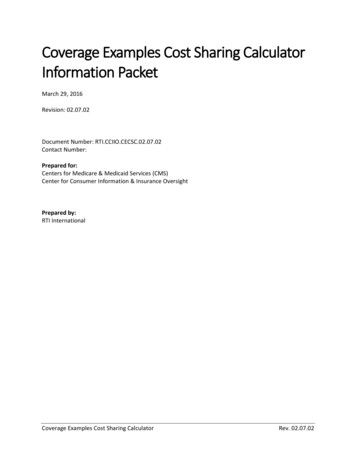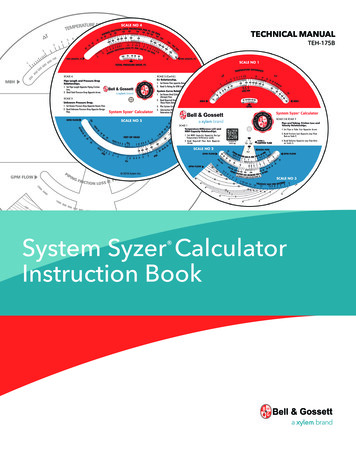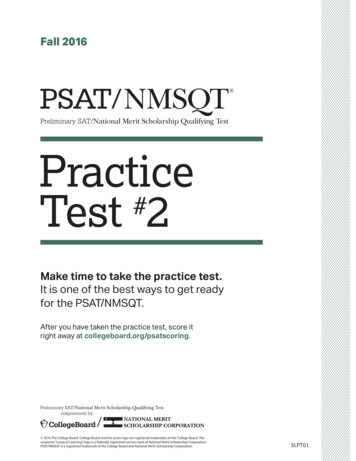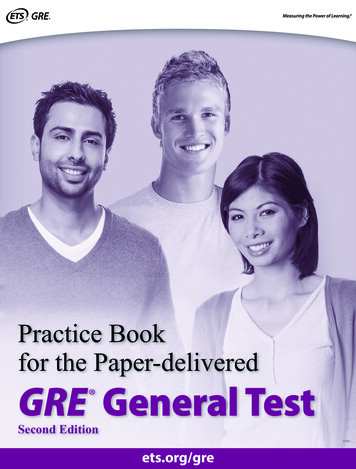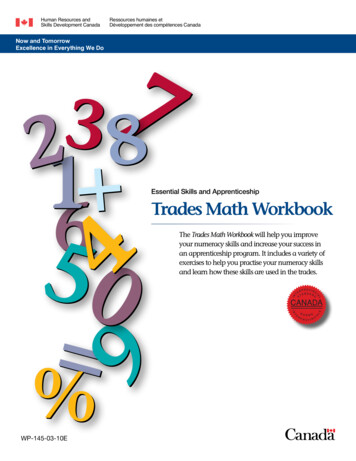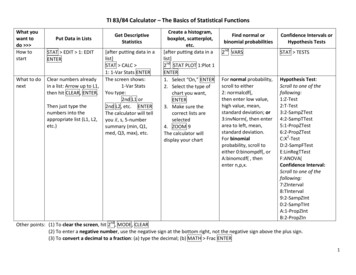
Transcription
TI 83/84 Calculator – The Basics of Statistical FunctionsWhat youwant todo How tostartWhat to donextPut Data in ListsSTAT EDIT 1: EDITENTERClear numbers alreadyin a list: Arrow up to L1,then hit CLEAR, ENTER.Then just type thenumbers into theappropriate list (L1, L2,etc.)Get DescriptiveStatistics[after putting data in alist]STAT CALC 1: 1-Var Stats ENTERThe screen shows:1-Var StatsYou type:2nd L1 or2nd L2, etc. ENTERThe calculator will tellyou ̅ , s, 5-numbersummary (min, Q1,med, Q3, max), etc.Create a histogram,boxplot, scatterplot,etc.[after putting data in alist]2nd STAT PLOT 1:Plot 1ENTER1. Select “On,” ENTER2. Select the type ofchart you want,ENTER3. Make sure thecorrect lists areselected4. ZOOM 9The calculator willdisplay your chartFind normal orbinomial probabilitiesConfidence Intervals orHypothesis Tests2nd VARSSTAT TESTSFor normal probability,scroll to either2: normalcdf(,then enter low value,high value, mean,standard deviation; or3:invNorm(, then enterarea to left, mean,standard deviation.For binomialprobability, scroll toeither 0:binompdf(, orA:binomcdf( , thenenter n,p,x.Hypothesis Test:Scroll to one of estE:LinRegTTestF:ANOVA(Confidence Interval:Scroll to one of -SampTIntA:1-PropZIntB:2-PropZInOther points: (1) To clear the screen, hit 2nd , MODE, CLEAR(2) To enter a negative number, use the negative sign at the bottom right, not the negative sign above the plus sign.(3) To convert a decimal to a fraction: (a) type the decimal; (b) MATH Frac ENTER1
Frank’s Ten Commandments of Statistics1.The probability of choosing one thing with a particular characteristic equalsthe percentage of things with that characteristic.2.Samples have STATISTICS. Populations have PARAMETERS.3.“Unusual” means more than 2 standard deviations away from the mean; “usual” means within 2standard deviations of the mean.4.“Or” means Addition Rule; “and” means Multiplication Rule5.If Frank says Binomial, I say npx.6.If σ (sigma/the standard deviation of the population) is known, use Z; if σ is unknown, use T.7.In a Hypothesis Test, the claim is ALWAYS about the population.8.In the Traditional Method, you are comparing POINTS (the Test Statistic and the Critical Value); in theP-Value Method, you are comparing AREAS (the P-Value and α (alpha)).9.If the P-Value is less than α (alpha), reject H0 (“If P is low, H0 must go”).10. The Critical Value (point) sets the boundary for α (area). The Test Statistic (point) sets the boundaryfor the P-Value (area).2
Chapters 3-4-5 – Summary NotesChapter 3 – Statistics for Describing, Exploring and Comparing DataCalculating Standard Deviation Finding the Mean and Standard Deviation from a Frequency DistributionPercentiles and Values s The percentile of value x x1314Total̅x– ̅-5-38Example:Speed42-4546-4950-5354-5758-61(x - ̅ )25964982̅ 6 (18/3)s 7̅ Midpoint (x)43.547.551.555.559.5 , so ̅ s Frequency ·x1087.5665360.5166.559.52339f · round to nearest whole number)To find the value of percentile k:L 46.8– , so s 4.1; this gives the location ofthe value we want; if it’s not a whole number,we go up to the next number. If it is a wholenumber, then the answer is the mean of thatnumber and the number above it.***Using the Calculator: To find mean & standard deviation of a frequency distribution or a probability distribution: First: STAT EDIT ENTER, then in L1 put inall the x values (midpoints if it’s a frequency distribution); in L2 put in frequencies or probabilities as applicable. Second: STAT CALC ENTER 1-Var Stats 2ND L1,2ND L2 ENTER. The screen shows the mean ( ̅ ) and the standard deviation, either Sx (if it’s a frequency distribution) or σx (if it’s a probability distribution).Chapter 4 - ProbabilityAddition Rule (“OR”)P(A or B) P(A) P(B) – P(A and B)Multiplication Rule (“AND”)P(A and B) P(A) · P(B A)Conditional ProbabilityP(B A) Find the probability of “at least 1” girl out of 3 kids, with boysand girls equally likely.*“All boys” means #1 is a boyAND #2 is a boy AND #3 is aboy, so we use theMultiplication Rule:.5 x .5 x .5 .125Permutations Rule (Items all Different)1. n different items available.2. Select r items without replacement3. Rearrangements of the same items areconsidered to be different sequences (ABC iscounted separately from CBA)Calculator example: n 10, r 8, so 10P8Hit 10 MATH PRB 2, then 8 ENTER 18144000 girls) P(all boys) .125*P(at least 1 girl) P(1, 2 or 3 girls) 1 minus .125 .875These are complements, so theircombined probability must 1.Permutations Rule (Some Items Identical)1. n different items available, and some areidentical2. Select all n items without replacement3. Rearrangements of distinct items areconsidered to be different sequences.# of permutations Fundamental Counting Rule: For a sequence of twoevents in which the first event can occur m ways and thesecond event can occur n ways, the events together canoccur a total of m · n ways.Factorial Rule: A collection of n different items can bearranged in order n! different ways. (Calculator Example:To get 4!, hit 4MATH PRB 4ENTERCombinations Rule1. n different items available.2. Select r items without replacement3. Rearrangements of the same items areconsidered to be the same sequence (ABC iscounted the same as CBA)Calculator example: n 10, r 8, so 10C8Hit 10 MATH PRB 3, then 8 ENTER 453
Formulas for Mean and Standard DeviationAll Sample Values Mean̅Std Dev Frequency Distribution ̅ ̅ Probability Distribution Chapter 5 - Discrete Probability DistributionsSec. 5.2A random variable is simply a number that can change, based on chance. It can either be discrete (countable, like how many eggs a hen might lay), orcontinuous (like how much a person weighs, which is not something you can count). Example: The number of Mexican-Americans in a jury of 12 members is arandom variable; it can be anywhere between 0 and 12. And it is a discrete random variable, because it is a number you can count.To find the mean and standard deviation of a probability distribution by hand, you need 5 columns of numbers: (1) x; (2) P(x); (3) x · P(x); (4) x2; (5) x2 · P(x).Using the Calculator: To find the mean and standard deviation of a probability distribution, First: STAT EDIT, then in L1 put in all the x values, and in L2 put inthe probability for each x value. Second: STAT CALC 1-Var Stats 1-Var Stats L1, L2 ENTER.Sec. 5.3 – 5.4 – Binomial ProbabilityRequirementsFixed number of trialsIndependent trialsTwo possible outcomesConstant probabilitiesFormulasµ n·p q 1-pUsing the Calculator1. To get the probability of a specific number: 2nd VARS binompdf (n, p, x) (which gives you theprobability of getting exactly x successes in n trials, when p is the probability of success in 1 trial).2. To get a cumulative probability: 2nd VARS binomcdf (n, p, x) (which gives you the probability ofgetting up to x successes in n trials, when p is the probability of success in 1 trial). IMPORTANT:there are variations on this one, which we will talk about. Be sure to get them clear in your mind.At most/less than or equal to:Less than:At least/greater than or equal to:Greater than/more than:Symbol SummarySampleHow many?MeanProportionStandard DeviationCorrelation Coefficientn̅sr̂ binomcdf(n,p,x)binomcdf(n,p,x-1)1 minus binomcdf(n,p,x-1)1 minus binomcdf(n,p,x)PopulationNµpσρ4
Chapters 6-7-8 – Summary NotesChTopicCalculator6Normal Probability Distributions3 Kinds of problems:1. You are given a point (value) andasked to find the corresponding area(probability)1a. Central Limit Theorem. Just like #1,except n 1.2. You are given an area (probability) andasked to find the corresponding point(value).3. Normal as approximation to binomialConfidence Intervals1. Proportion̂Formulas, Tables, Etc.1. 2nd VARS normalcdf (low, high, µ,σ)1a. 2nd VARS normalcdf (low, high, µ , )nd2. 2 VARS invNorm (area to left, µ, σ)3. Step 1: Using binomial formulas, findmean and standard deviation.Table A-2.3. (cont’d – Normal as approximation to binomial) – Step 2:If you are asked to findThen in calculatorP(at least x)normalcdf(x-.5,1E99,µ,σ)P(more than x)normalcdf(x .5,1E99,µ,σ)P(x or fewer)normalcdf(-1E99,x .5,µ,σ)P(less than x)normalcdf(-1E99,x-.5,µ,σ)1.̂1. STAT TEST 1PropZInt7̅ Min. Sample Size ( ̂ known):2. STAT TEST ZInt OR STAT TEST TInt 2.(use Z if σ is known, T if σ is unknown)Minimum Sample Size: PRGM NMEAN Min. Sample Size ( ̂ unknown):Minimum Sample Size: PRGM NPROP2. Mean (z or t?)̅̂ sample proportion; E zα/2 ̂ ̂ ̅ sample mean; E zα/2or E tα/2Min. Sample Size:̂̂(σ known) (σ unknown) n [ ]3. Standard Deviation σ Hypothesis Tests1. Proportion82. Mean (z or t?)3. Standard DeviationIf P-Value α,reject H0; if PValue α failto reject H0.3. PRGM INVCHISQ (to findand )PRGM CISDEV (to find Conf. Interval.)3. Use Table A-4 to find1. STAT TEST 1PropZTest1. Test Statistic: z 2. STAT TEST ZTest OR TTest2. Test Statistic: z 3. PRGM TESTSDEV3. Test Statistic: X2 and̂ ̅̅ OR t ̅̅ See additionalsheet on 1sentencestatement andfinding CriticalValue.5
Hypothesis Tests1-Sentence Statement/Final ConclusionClaim is H0Claim is H1Reject H0 (Type There is sufficient evidence toThe sample data support the1 – reject truewarrant rejection of the claimclaim that . . .Ho)that . . .Fail to reject H0 There is not sufficient evidenceThere is not sufficient(Type II – fail to to warrant rejection of the claim sample evidence to supportreject false Ho) that . . .the claim that . . .Hypoth Test ChecklistCLAIMHYPOTHESESSAMPLE DATAαCALCULATOR: P-VALUE,TEST STATISTICCONCLUSIONSTo find Critical Value(required only for Traditional Method, not for P-Value Method)Critical Z-ValueLeft-Tail Test (1 negative CV)2nd VARS invNorm(α) ENTERRight-Tail Test (1 positive CV)2nd VARS invNorm(1-α) ENTERTwo-Tail Test (1 neg & 1 pos CV)2nd VARS invNorm(α/2) ENTERCritical T-Value (when you get to Chapter 9, for TWO samples, for DF use the smaller sample)Left-Tail Test (1 negative CV)Right-Tail Test (1 positive CV)Two-Tail Test (1 neg & 1 pos CV)PRGM INVT ENTERPRGM INVT ENTERPRGM INVT ENTERAREA FROM LEFT αAREA FROM LEFT 1-αAREA FROM LEFT α/2DF n-1 ; then hit ENTERDF n-1; then hit ENTERDF n-1; then hit ENTERCritical X2-ValueLeft-Tail Test (1 positive CV)PRGM INVCHISQ ENTER ENTERDF n-1 ENTER ENTERAREA TO RIGHT 1 - αRight-Tail Test (1 positive CV)PRGM INVCHISQ ENTER ENTERDF n-1 ENTER ENTERAREA TO RIGHT αTwo-Tail Test (MUST DO TWICE)PRGM INVCHISQ ENTER ENTERDF n-1 ENTER ENTERAREA TO RIGHT:1st time: α/2 ( )2nd time: 1 - α/2 ()6
Chapters 9-10-11 – Summary NotesChapter 9 – Inferences from Two Samples (Be sure to use Hypothesis Test Checklist)Hypothesis Test(Be sure to use HypothTest checklist)Proportions (9-2)Calculator: 2-PropZTestFormulas:̂̂ ̅ ̅ ̅p1 – p2always 0.̅ ̅ H0: p1 p2; H1: p1 or or p2Confidence IntervalMeans (9-3) (independent samples)Calculator: 2-SampleTTest̅̅ µ1 - µ2always 0 Matched Pairs (9-4) (dependent samples)Calculator: (1) Enter data in L1 and L2, L3equals L1 – L2; (2) TTest (which gives you all thevalues you need to plug into the formula)̅µd always 0 H0: µ1 µ2; H1: µ1 or or µ2H0: µd 0; H1: µd or or 0Calculator: 2-PropZInt.Calculator: 2-SampleTIntCalculator: TIntervalNo formulas. If interval contains 0, then fail to reject. If for a 1-tail Hypo. Test is .05, the CL for Conf. Int. is 0.9 (1 - 2 ).Chapter 10 – Correlation and Regression (don’t use formulas, just calculator; the important thing is interpreting results.)Question to be answeredHypothesis Test: Is there a linearcorrelation between two variables,x and y? (10-2)r is the sample correlationcoefficient. It can be between -1and 1.When you have 2 variables x and y,how do you predict y when you aregiven a particular x-value? (10-3)When you have 2 variables x and y,how do you predict an intervalestimate for y when you are givena particular x-value? (10-4)How much of the variation in y isexplained by the variation in x?(10-4)Calculator and Interpretation (Anderson: show value of t but not formula)Calculator: Enter data in L1 and L2, then STAT Test LinRegTTest. (Reg EQ VARS, Y-VARS, Function, Y1). P-Value tellsyou if there is a linear correlation. The test statistic is r, which measures the strength of the linear correlation.Interpretation: x is the explanatory variable; y is the response variable. H0: there no linear correlation; H1: there is a linearcorrelation. So, if P-Value , you reject H0, so there IS a linear correlation; if P-Value , you fail to reject H0, so there isNO linear correlation.Calculator: To create a scatterplot: Enter data in L1 and L2, then LinRegTTest; then 2nd Y Plot 1 On, select correct typeof plot. Then Zoom 9 (ZoomStat). To delete regression line from graph, Y , then clear equation from Y1.Two possible answers:(1) If there is a significant linear correlation, then you need to determine the Regression Equation (y a bx; LinRegTTestgives you a and b), then just plug in the given x-value. Or the easy way to find y for any particular value of x:Calculator: VARS Y-Vars 1:Function Enter Enter Input x-value in parentheses after Y1(2) If there is no significant linear correlation, then the best predicted value for y ̅. Calculator: VARS, 5, 5, ENTER.1. PROGRAM, INVT ENTER Area from left is 1- /2, DF n-2. This gives you t Critical Value.2. PROGRAM, PREDINT ENTER Input t Critical Value from Step 1, then input X value given in the problem. Hit Enter twiceto get the Interval.The percentage of variation in y that is explained by variation in x is r2, the coefficient of determination.Calculator: to find r2, enter data in L1 and L2, then LinRegTTest. It will give you r2. 1 sentence conclusion: “[r2]% of thevariation in [y-variable in words] can be explained by the variation in [x-variable in words].”Total Variation is ̅ . Explained Variation is Total Variation times r2. Unexplained Variation is Total Variationminus Explained Variation. To find them all, put x values in L1; put y values in L2; LinRegTTest; then PRGM VARATION.7
Chapter 10 - continuedFinding Total Deviation,Explained Deviation, andUnexplained Deviation,for a point. (10-4)Variation and Deviation are similar, but different. Variation relates to ALL the points in a set of correlated data. Deviationrelates to ONE specific point in a set of correlated data. Total Deviation for a specific point ̅ (the actual ycoordinate of the point minus the mean of all the y values). Explained Deviation for the point ̂ ̅ (the predicted valueof y when the x-coordinate of that point is plugged into the regression equation, minus the mean of all the y values).Unexplained Deviation for the point ̂ (the actual y-coordinate of the point minus the predicted value of y when thex-coordinate of that point is plugged into the regression equation).Chapter 11 – Chi-Square (X2) Problems (Hypothesis Tests, use checklist)Claim to be testedThe claim that an observedproportion (O) or or anexpected proportion (E). Thisis called “goodness of fit.”(11-2) *3 SAMPLES WITHPROPORTION*CalculatorEnter O data in L1 and E data in L2.PROGRAM BESTFIT ENTEREnter number of categories (k),then Enter,Gives you Chi-Square (X2) and PValueFormulas, etc.Two types of claims: equal proportions or unequal proportions: Equal: H0: p1 p2 p3; H1: at least one is not equal Unequal: H0: p1 .45, p2 .35, p3 .20; H1: at least one is not equal to the claimedproportion Hypothesis Test is always right-tailTest Statistic is X2 (Chi-Square) To find P-Value from Test Stat: X2cdf(TS,1E99,k-1) 2 Given a table of data withrows and columns, the claimthat the row variable isINDEPENDENT of the columnvariable. This is called“contingency tables.” (11-3)2nd MATRX EDIT, select [A], makesure number of rows and numberof columns are correct, then enterthe values in the matrix.STAT Tests, X2 – Test; Observed is[A] and Expected is [B], hit Calc; itgives you X2 and P-Value.Example hypotheses: H0: pedestrian fatalities are independent of intoxication of driver ;H1: pedestrian fatalities dependon intoxication of driver.E (the expected value) for any cell (row total x2column total) / grand total, OR get all E-values on calculator with 2nd MATRX Edit [B] Enter2To find X CV, df (r-1)(c-1).Chapter 11 – Analysis of Variance (ANOVA) (Hypothesis Tests, use checklist)Claim to be testedCalculatorThe claim that 3 or morepopulation means are allequal (H0), or are not all equal(H1). This is called “Analysisof Variance.” (11-4) * 3SAMPLES WITH MEAN*Enter data in L1, L2, etc.STAT Tests, ANOVA (L1, L2, L3). Gives you Fand PV, but also gives you Factor: df, SS andMS, and Error: df, SS and MS, which you needto plug into the formula.Formulas, etc. (must show formulas in both symbolic form and also withgiven data plugged in, but can get the answer from calculator)The test statistic is F. H0: 1 2 3; H1: at least one mean is not equal.F SS FactorSS stands for “Sum of Squares”df MS FactorMS stands for “Mean Squares”SS ErrorMS ErrordfMS(total) SS(total)/(N-1). N total number of values in all samples combined8
Overview of Chapters 7, 8 and 9ONE-Sample ProblemsType ofProblemProportionMean –σ knownMean –σ unknownStandardDeviationTWO-Sample ProblemsChapter 7Chapter 8Confidence IntervalHypothesis Test1-Prop Z Int1-Prop Z TestZ IntervalZ TestT IntervalT TestPRGM S2INT (Toma);orPRGM INVCHISQ PRGM CISDEVPRGM S2TEST (Toma);orPRGM TESTSDEVChapter 9Type of ProblemProportionMean –IndependentSamplesMean –DependentSamples(Matched Pairs)ConfidenceInterval2-Prop Z IntHypothesis Test2-Prop Z Test2-Samp T Int2-Samp T TestT IntervalT TestMinimum Sample Size Problems (Chapter 7)Chapter 7 also has another kind of problem, called Minimum Sample Size Problems.These problems may ask you to find the minimum sample size, but usually they just say “How many . . .?”Minimum Sample Size problems can be Proportion problems, Mean problems or Standard Deviation problems. Proportion problems: Use PRGM NPROP. This program asks you for SAMPLE P. If the problem gives you a Sample P (like 60%), then justenter that, as a decimal. If the problem does NOT give you a Sample P, then enter 0.5. Mean problems: Use PRGM NMEAN.Both programs (NPROP and NMEAN) ask you for the Margin of Error. Sometimes the Margin of Error is clear from the problem. But if you see theword “within” in the problem, the margin of error is whatever comes immediately after the word “within.” Standard Deviation problems: You are very rarely asked to find the Minimum Sample Size for a Standard Deviation problem. The only wayto answer this kind of problem is by looking at the table in the Triola Text, which is on page 364 of the 4th Edition.9
Finding the key words in a problem (Ch. 6, 7 and 8)SampleStatisticsSample ProblemKey Words1. Assume that heights of men are normally distributed, witha mean of 69.0 in. and a standard deviation of 2.8 in. A daybed is 75 in. long. Find the percentage of men with heightsthat exceed the length of a day bed.“normally distributed” tells you it’s probably a Ch. 6 question.“Find the percentage” tells you it’s a Type 1 Ch. 6 question (use normalcdf)NA2. Assume that heights of men are normally distributed, witha mean of 69.0 in. and a standard deviation of 2.8 in. Indesigning a new bed, you want the length of the bed toequal or exceed the height of at least 95% of all men.What is the minimum length of this bed?“normally distributed” tells you it’s probably a Ch. 6 question.“What is the minimum length” tells you it’s NOT a Type 1 Ch. 6 question, so it’sa Type 2 Ch. 6 question (use invNorm)NA3. The cholesterol levels of men aged 18-24 are normallydistributed with a mean of 178.1 and a standard deviationof 40.7. If 1 man aged 18-24 is randomly selected, find theprobability that his cholesterol level is greater than 260.“normally distributed” tells you it’s probably a Ch. 6 question.“Find the probability” tells you it’s a Type 1 Ch. 6 question (use normalcdf)NA4. In a poll of 745 randomly selected adults, 589 said that itis morally wrong to not report all income on tax returns.Construct a 95% confidence interval estimate of thepercentage of all adults who have that belief.“poll” and “randomly selected” both tell you the sentence is about a sample.“Construct a confidence interval” tells you you’re constructing a confidenceinterval (Ch. 7), NOT testing a hypothesis (Ch. 8).“Percentage” tells you it’s a proportion problem, not a mean or standarddeviation problem.n 745x 5895. You must conduct a survey to determine the mean incomereported on tax returns. How many randomly selectedadults must you survey if you want to be 99% confidentthat the mean of the sample is within 500 of the truepopulation mean?“How many” tells you you are finding a minimum sample size.“Mean” tells you you’re finding a minimum sample size for a mean, not for aproportion.“Within” tells you that the next thing you see ( 500) is the margin of error.NA6. A simple random sample of 37 weights of pennies has amean of 2.4991g and a standard deviation of 0.0165g.Construct a 99% confidence interval estimate of the meanweight of all pennies.“Construct a confidence interval” tells you’re constructing a confidence interval(Ch. 7), NOT testing a hypothesis (Ch. 8).“Mean” tells you you’re constructing a confidence interval for a mean, not for aproportion.The phrase “and a standard deviation” is in a sentence about the sample, soyou know the sample standard deviation (s), but you don’t know the populationstandard deviation (σ), so you will use t, not z.n 37̅s 0.016510
7. The Town of Newport has a new sheriff, who compiles recordsshowing that among 30 recent robberies, the arrest rate is 30%,and she claims that her arrest rate is higher than the historical25% arrest rate. Test her claim.“Records” tells you you are getting information about a sample.“Rate” tells you that this is a proportion problem, not a mean problemor standard deviation problem.“Claim” and “Test her claim” tell you that this is a Hypothesis Test (Ch.8) not a Confidence Interval (Ch. 7).n 30̂8. The totals of the individual weights of garbage discarded by 62households in one week have a mean of 27.443 lb. Assume thatthe standard deviation of the weights is 12.458 lb. Use a 0.05significance level to test the claim that the population ofhouseholds as a mean less than 30 lb.“Assume” tells you that the standard deviation you are being given is apopulation standard deviation (σ), so you will use z, not t.“Test the claim” tell you that this is a Hypothesis Test (Ch. 8) not aConfidence Interval (Ch. 7).“Mean” tells you you are testing a claim about a mean, not about aproportion or standard deviation.“Significance level” is α (alpha)n 62̅̂ 9α 0.0511
Chapter 8 - Frank’s Claim BuffetThe Claim in Words1. Test the claim that less than ¼ of such adults smoke.Claim BuffetP Somenumber µ .25σ 2. Test the claim that most college students earnbachelor’s degrees within 5 yearsP Somenumber µ .5σ “most”justmeansmorethan half 3. Test the claim that the mean weight of cars is less than3700 lbP Somenumber µ 3700σ 4. Test the claim that fewer than 20% of adults consumedherbs within the past 12 months.P Somenumber µ .20σ 20% tellsyou theclaim isabout aproportion 12
5. Test the claim that the thinner cans have a mean axialload that is less than 282.8 lbP Somenumber µ 282.8σ 6. Test the claim that the sample comes from a populationwith a mean equal to 74.P Somenumber µ 74σ 7. Test the claim that the standard deviation of theweights of cars is less than 520.P Somenumber µ 520σ 13
Hit 10 MATH PRB 2, then 8 ENTER 1814400 Permutations Rule (Some Items Identical) 1. n different items available, and some are identical 2. Select all n items without replacement 3. Rearrangements of distinct items are considered to be different sequences. # of permutations Combinations Rule 1. n different items available. 2.


